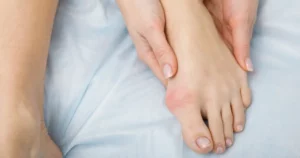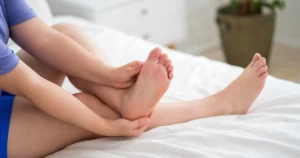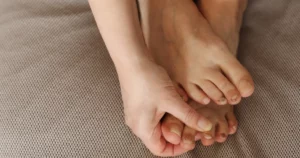
Table of Contents
Toe deformities like bunions, hammer toes, and claw toes affect millions of people, causing pain and limiting mobility. These conditions often worsen over time, significantly impacting quality of life. Integrity Foot & Ankle Associates is a beacon for those seeking specialized care. Fortunately, advances in minimally invasive treatments offer practical solutions with reduced recovery times and minimal scarring. We explore joint toe deformities and provide an in-depth look at the latest minimally invasive procedures.
Overview of Common Toe Deformities
Toe deformities affect millions of people, causing discomfort and reducing mobility. Here’s an overview of the most common toe deformities and their symptoms:
- Hammer Toe: Hammer’s toe occurs when the toe’s middle joint becomes abnormally bent, giving the toe a hammer-like appearance. This deformity usually affects the second, third, or fourth toe. The causes are tight or ill-fitting footwear, muscle imbalance, injury to the toe, and arthritis. The symptoms are pain or discomfort, especially when wearing shoes, corns, or calluses on the top of the affected joint, and difficulty or pain while moving the toe. The treatment is in its early stages and often responds to conservative treatments like orthotics or toe exercises. In more severe cases, minimally invasive treatments such as percutaneous tenotomy offer quick and effective relief.
- Bunions: Bunions are bony protrusions that form at the base of the big toe and cause it to turn towards the other toes, creating a visible lump on the foot. Causes include genetics, tight shoes, high heels, arthritis, and foot injuries. Symptoms include pain, redness, swelling, and limited significant toe movement. Mild cases can be treated with orthotic devices and anti-inflammatory medication. Severe cases can be treated with minimally invasive therapies such as percutaneous osteotomy or arthroscopic surgery.
- Mallet Toe: Mallet’s toe occurs when the joint at the end of the toe becomes bent downward, resembling a mallet. Causes are wearing high heels or tight shoes, injury to the toe, arthritis, and muscle imbalance. Symptoms are pain at the tip of the affected toe, corns or calluses at the tip or top of the toe, and difficulty moving the toe. Early-stage mallet toe treatment often responds to splints, pads, or orthotics. Advanced cases benefit from minimally invasive procedures like percutaneous tenotomy or osteotomy.
- Claw Toe: When the middle and end joints of the toe bend, the toes appear claw-like. Nerve damage, tight or poorly-fitting shoes, arthritis, or muscle imbalance can cause it. In addition to pain and discomfort, affected toes may have corns or calluses and limited movement. Conservative treatments include toe exercises, orthotic devices, and more spacious footwear. For more severe cases, percutaneous tenotomy can be an effective treatment option with minimal recovery time.
- Overlapping Toes: When one toe lies on top of another, friction and discomfort result. Causes include Genetics (family history), tight or narrow shoes, arthritis, and trauma or injury. Symptoms include pain or discomfort due to rubbing or pressure, corns or calluses at the overlap site, and an inability to straighten the affected toes. Treatment: Corrective devices like toe spacers or orthotics can help in mild cases. Minimally invasive surgery may be required to realign the toes for persistent issues.
Minimally Invasive Treatment Techniques for Toe Deformities
Toe deformities like bunions, hammers, and claw toes can be painful and limit mobility. Fortunately, minimally invasive techniques offer effective treatment options with less downtime and minimal scarring.
- Percutaneous Tenotomy: Percutaneous tenotomy involves releasing a tight tendon through a small incision or needle puncture to correct toe deformities. Suitable Conditions are hammer toe, Claw toe, and Mallet toe. Procedure: The surgeon makes a small incision or puncture near the affected joint. They carefully release the tight tendon using a special needle or small instrument. The toe immediately straightens after the tendon is released.
- Percutaneous Osteotomy: Percutaneous osteotomy is a procedure to correct toe deformities like bunions, hammer toes, claw toes, and mallet toes. The surgeon cuts and realigns bones through tiny incisions using specialized tools. A small wire or screw may hold the bone in its new position.
- Arthroscopic Surgery: An arthroscopic surgery treats toe deformities using a minimally invasive technique. It’s suitable for bunions, hammer toes, and related joint disorders. A small incision is made to insert the camera and specialized tools to smooth or realign joint surfaces.
- Cryotherapy: Cryotherapy relieves nerve pain and inflammation, and extreme cold treats toe deformities. A specialized cryoprobe delivers extreme cold to the affected nerve or tissue, numbing the nerve or reducing inflammation. The procedure is minimally invasive when performed under local anesthesia. It effectively manages nerve pain and inflammation and can be repeated if necessary.
- Minimally Invasive Bunionectomy: Minimally invasive bunionectomy is a suitable surgery for bunions. The surgeon makes a small incision near the bunion and removes it using specialized instruments. A tiny screw or pin may be used to support healing. Compared to traditional surgery, it offers reduced pain and scarring, faster recovery, and precise correction of the bunion deformity.
Choosing the Right Specialist and Clinic for Toe Deformities
Finding the right specialist and clinic can make all the difference when seeking treatment for toe deformities such as bunions, hammer toes, or claw toes.
- Look for Specialized Foot and Ankle Expertise: Toe deformities like Integrity Foot & Ankle Associates require specialized knowledge. Choose a podiatrist or orthopedic surgeon specializing in foot and ankle care. Verify board certification in podiatric medicine or orthopedic surgery. Look for fellowship training in foot and ankle surgery.
- Prioritize Experience with Minimally Invasive Techniques: Minimally invasive treatments demand a high skill level. Seek specialists with extensive experience performing these procedures. Ask how many minimally invasive procedures for toe deformities you have performed. What is your success rate for these treatments? Can you provide patient testimonials or before-and-after photos?
- Evaluate Clinic Reputation and Patient Reviews: Check the clinic’s online reviews to gauge patient satisfaction. Look for consistent positive feedback regarding treatment outcomes, professionalism, and patient care.
- Consider the Range of Services Offered: Find a clinic providing diagnosis and rehabilitation services for toe deformities.
- Review Clinic Facilities and Technology: A commitment to quality care is evident at Integrity Foot & Ankle Associates, with advanced imaging technology for accurate diagnosis, state-of-the-art surgical suites for minimally invasive procedures, and comfortable recovery areas for post-operative care.
Consult a Professional
Toe deformities, such as bunions, hammer, and claw toes, can cause pain and restrict mobility. Thankfully, minimally invasive techniques provide effective treatment options with reduced downtime and minimal scarring. Consulting with a certified podiatrist will provide clarity and guide individuals toward the best foot treatment option.
Takeaway
Don’t let toe deformities hold you back any longer. At Integrity Foot & Ankle Associates, our specialized team provides personalized, minimally invasive treatments to help you step confidently toward healthier feet. With our comprehensive care and state-of-the-art techniques, you’ll regain mobility and improve your quality of life. Contact us today or book an appointment online to discover how we can help you overcome bunions, hammer toe, and other toe deformities.




